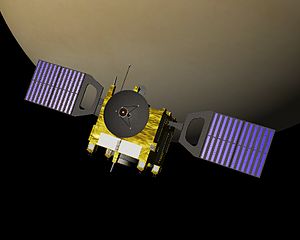 Venus Express in orbit | |
| Mission type | Venus orbiter |
|---|---|
| Operator | European Space Agency |
| COSPAR ID | 2005-045A |
| SATCAT no. | 28901 |
| Website | www |
| Mission duration | Planned: 2 years Final: 9 years, 2 months, 9 days |
| Spacecraft properties | |
| Manufacturer | EADS Astrium |
| Launch mass | 1,270 kg (2,800 lb)[1] |
| Dry mass | 700 kg (1,500 lb)[1] |
| Payload mass | 93 kg (205 lb)[1] |
| Dimensions | 1.5 × 1.8 × 1.4 m (4.9 × 5.9 × 4.6 ft)[1] |
| Power | 1,100 watts[1] |
| Start of mission | |
| Launch date | 9 November 2005, 03:33:34 UTC[2] |
| Rocket | Soyuz-FG/Fregat |
| Launch site | Baikonur 31/6 |
| Contractor | Starsem |
| End of mission | |
| Disposal | Deorbited |
| Last contact | 18 January 2015, 15:01:55 UTC[3] |
| Decay date | January / February 2015 |
| Orbital parameters | |
| Reference system | Cytherocentric |
| Pericytherion altitude | 460 km (290 mi)[4] |
| Apocytherion altitude | 63,000 km (39,000 mi)[4] |
| Inclination | 90 degrees[5] |
| Period | 24 hours[5] |
| Venus orbiter | |
| Orbital insertion | 11 April 2006 |
 ESA Solar System insignia for the Venus Express mission | |
Venus Express (VEX) was the first Venus exploration mission of the European Space Agency (ESA). Launched in November 2005, it arrived at Venus in April 2006 and began continuously sending back science data from its polar orbit around Venus. Equipped with seven scientific instruments, the main objective of the mission was the long term observation of the Venusian atmosphere. The observation over such long periods of time had never been done in previous missions to Venus, and was key to a better understanding of the atmospheric dynamics. ESA concluded the mission in December 2014.[6]
- ^ a b c d e "Venus Express Factsheet". European Space Agency. 1 June 2014. Retrieved 5 July 2017.
- ^ Siddiqi, Asif (2018). Beyond Earth: A Chronicle of Deep Space Exploration, 1958–2016 (PDF) (second ed.). NASA History Program Office.
- ^ Scuka, Daniel (23 January 2015). "Venus Express: The Last Shout". European Space Agency. Retrieved 26 January 2015.
- ^ a b "Venturing into the upper atmosphere of Venus". European Space Agency. 11 November 2014. Retrieved 23 November 2014.
- ^ a b "Operational Orbit". European Space Agency. 14 December 2012. Retrieved 23 November 2014.
- ^ Bauer, Markus; Svedhem, Håkan; Williams, Adam; Martin, Patrick (16 December 2014). "Venus Express goes gently into the night". European Space Agency. Retrieved 22 December 2014.